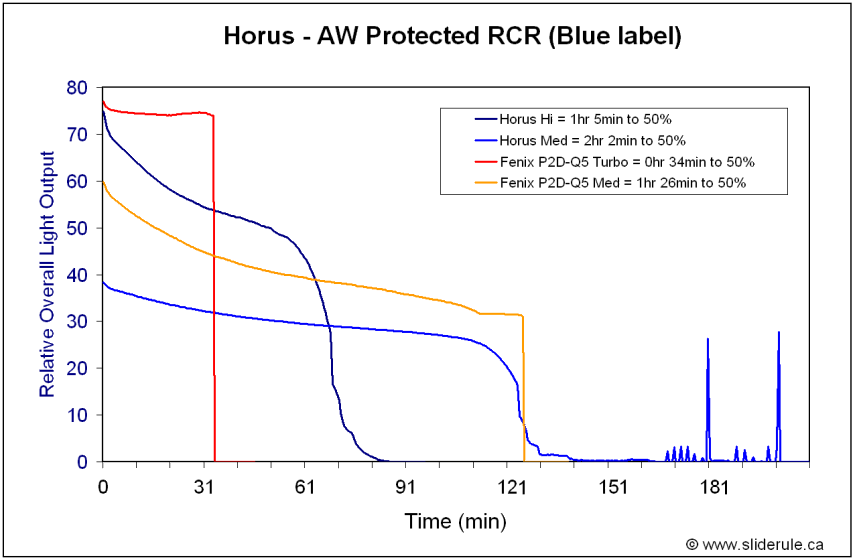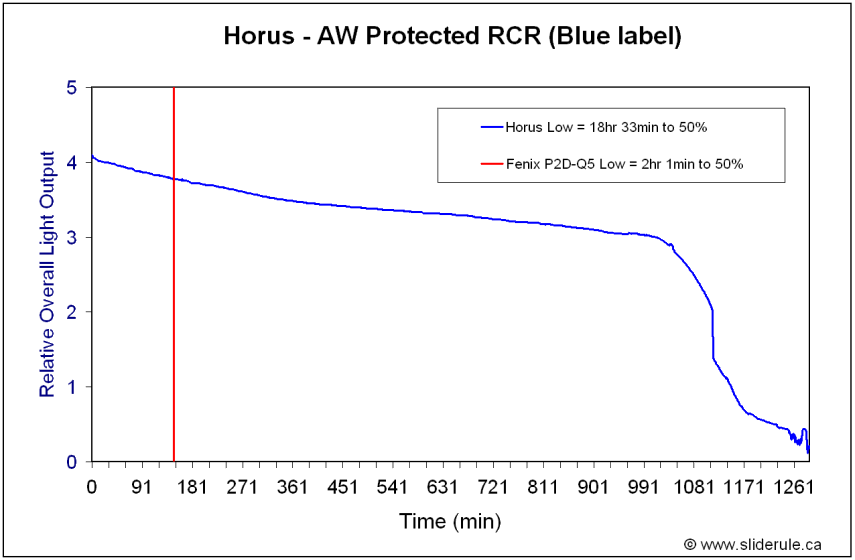This light was provided by Scabal at no charge for review. Information on this Horus FD-1.3 Titanium light is available on CPFMP. This is just my preliminary review - more details will come soon.
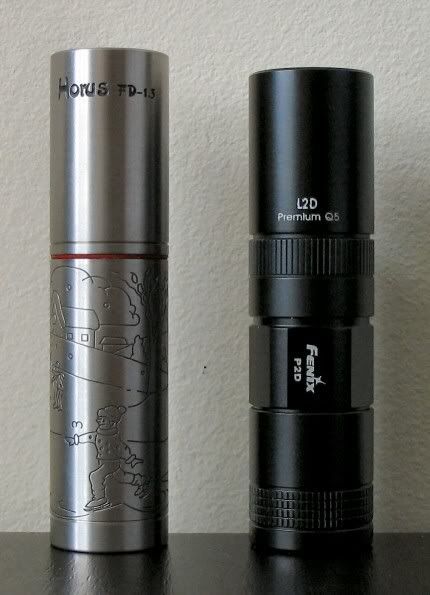
Full details are available in their CPFMP thread, but here's a quick rundown:
What came in the package:
For the moment, Steven at Horus has only sent me the light for testing. Full package with extras will be coming soon. Here's what the light looks like:
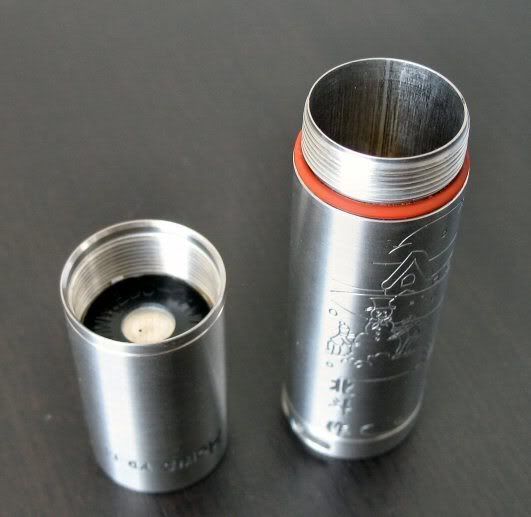
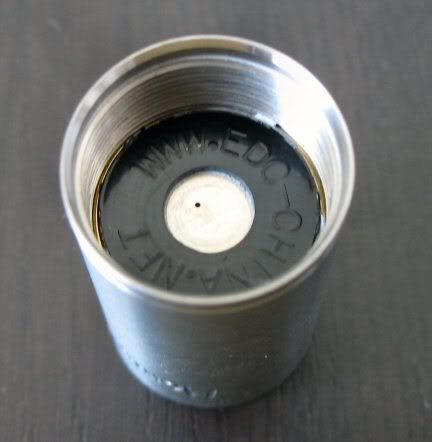
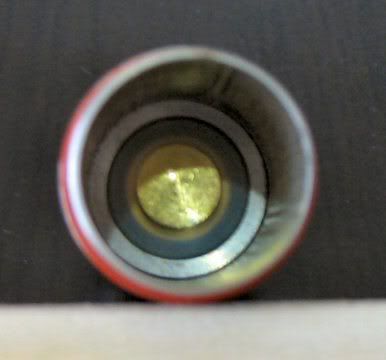
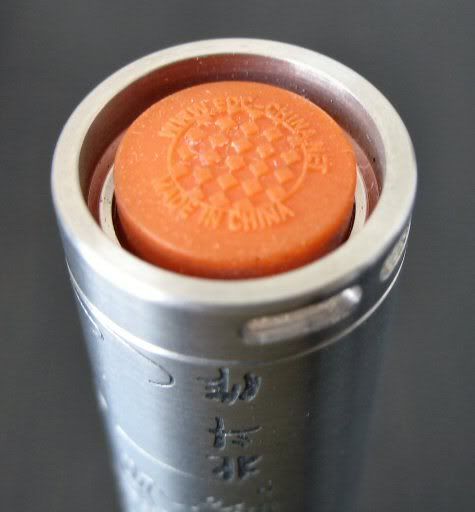
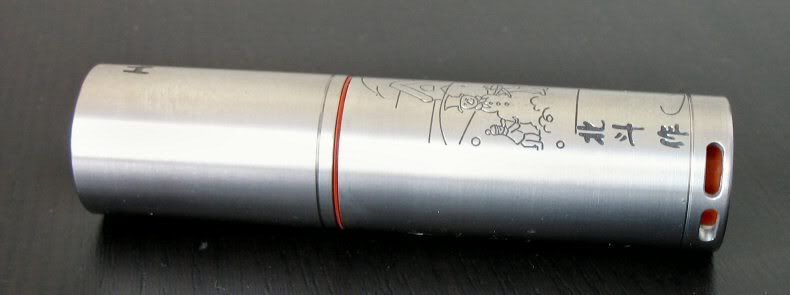
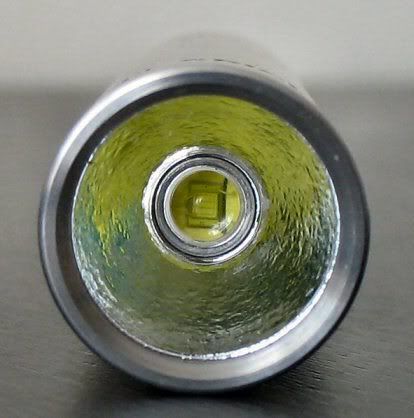
Beamshots:
On Max with AW protected RCR (blue-label). For comparison purposes, I've also included the Fenix P2D-Q5.
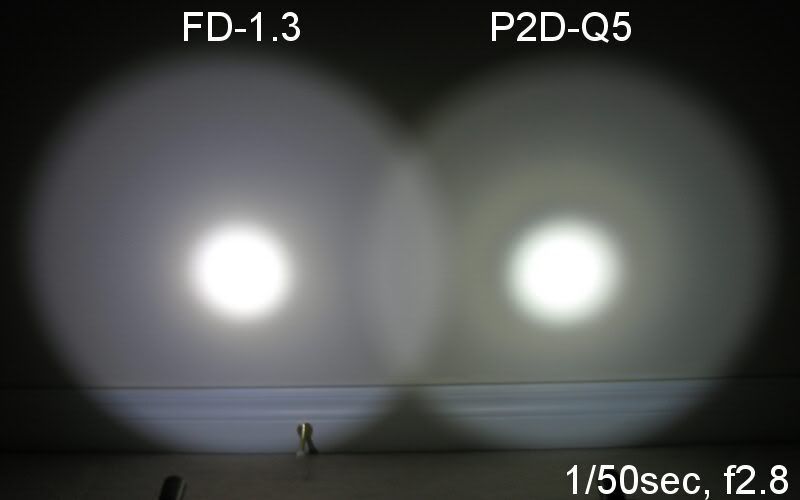
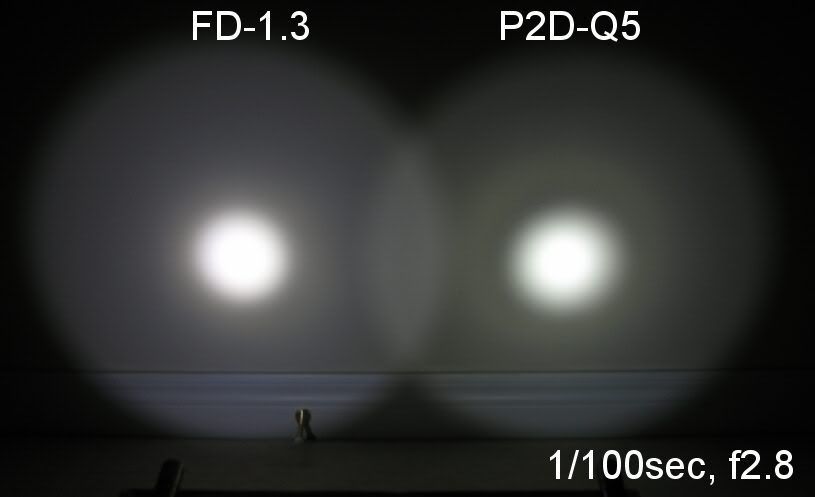
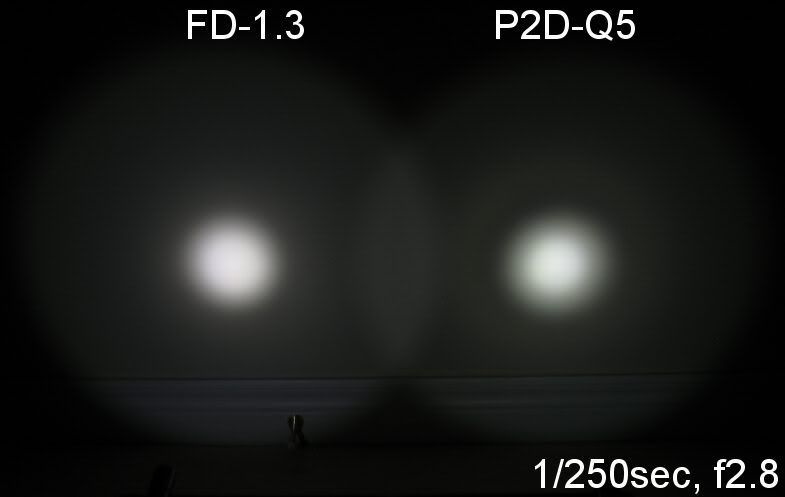
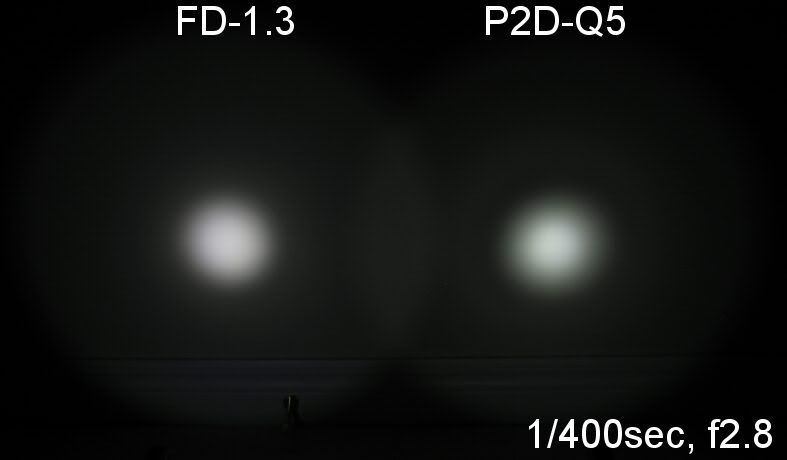
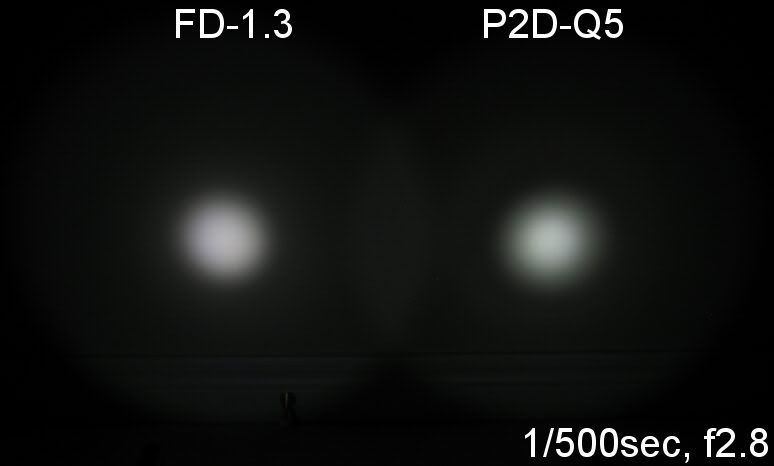
As you can see, the Horus FD-1.3 has a much smoother beam than the Fenix Q5 head, with no sign of the dreaded Cree rings. Initial overal output on max is similar. Tint does indeed seem to be WC on my sample (the Fenix is warm in comparison)
Output/Runtime Method: All my output numbers are relative for my home-made light box setup, a la Quickbeam's flashlightreviews.com method. My relative overall output numbers are typically similar to his, although generally a little lower. You can directly compare all my review graphs - i.e. an output value of "10" in one graph is the same as "10" in another.
Battery Comparison:
Batteries used for testing purposes were AW protected RCR (black-label and older blue-label, 750mAh, 3.7V), Ultrafire Protected RCR (gray-label, "880mAh", 3.6V) and Ultrafire Unprotected RCR (blue-label, "880mAh", 3.7V). The AW batteries were bought direct from AW, and both have had a good number of charging cycles (i.e. blue-label at least a year old, black-label at least 6 months old). The Ultrafires were just purchased from Lighthound, and are brand new.
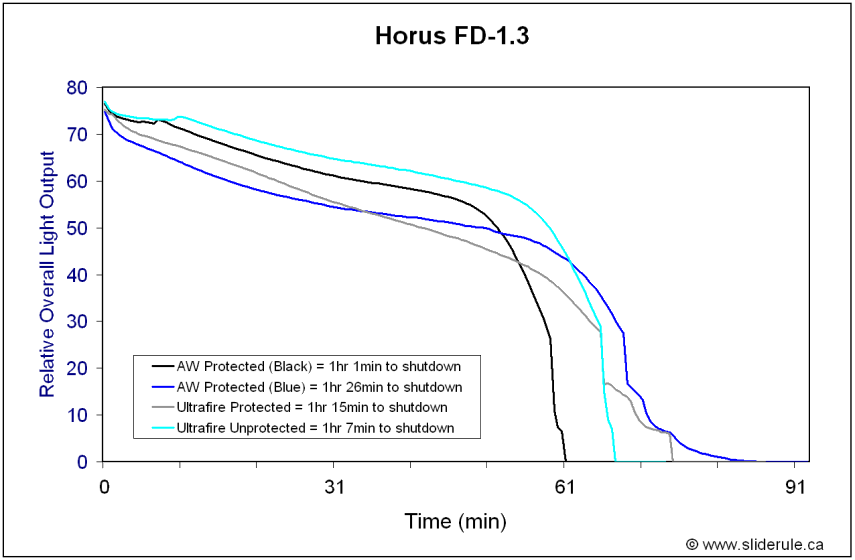
As you can see, all batteries performed similarly. And given the large number of discharge cycles on my AWs, that tells you something about the supposed "higher" capacity of the brand new Ultrafires.
The light features a low voltage cut-off of 3.2V, so it is quite safe to run unprotected batteries in this light. I confirmed the resting voltage of the unprotected ultrafire was 3.2V as soon as shutdown occured.
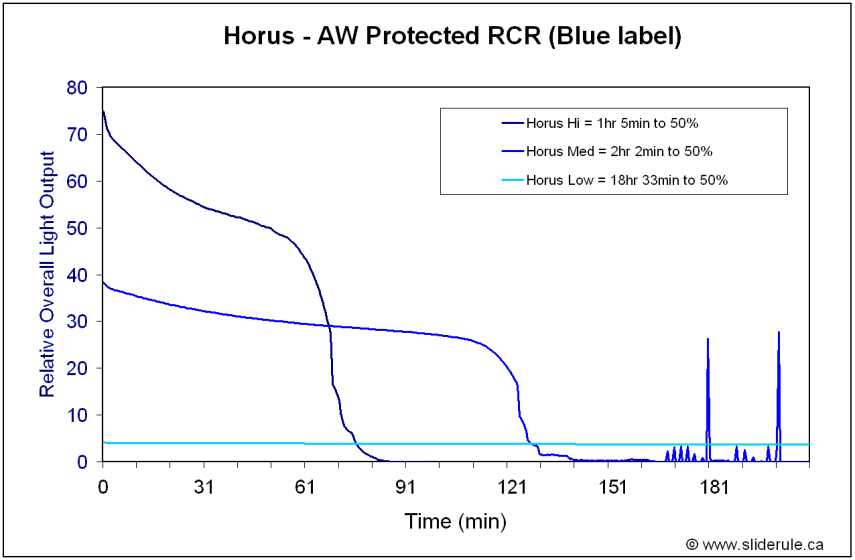
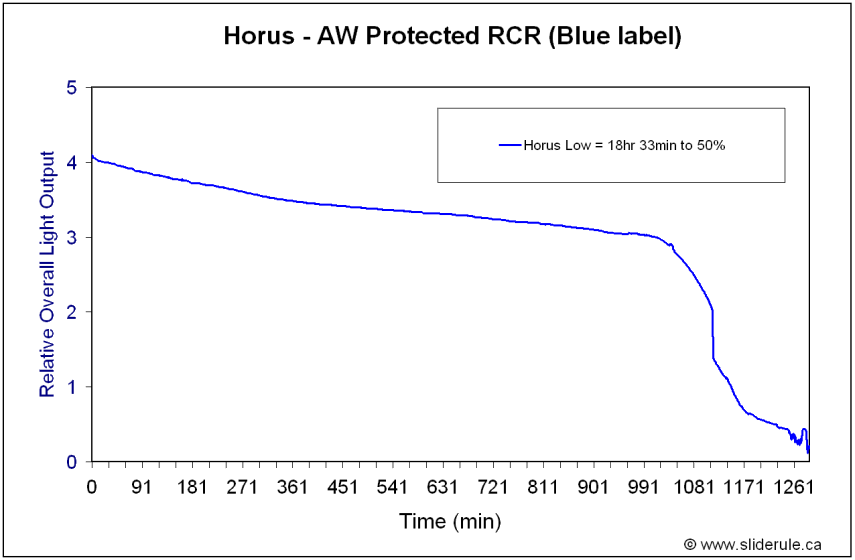
As you will notice, light goes into a slow flash/strobe mode on Medium and Low modes once the low voltage protection level is reached. In both cases, I stopped the run after several minutes of flashing. Note that this flash/strobe effect doesn't seem to happen when the light is run on Max mode (i.e. simply shuts off once internal battery protection circuit is tripped, or when 3.2V is reached on unprotected batteries).
Throw Summary:
Hi: 2600 Lux
Med: 1300 Lux
Lo: 120 Lux
Digital Regulation:
User Interface:
Build Quality
Accessories
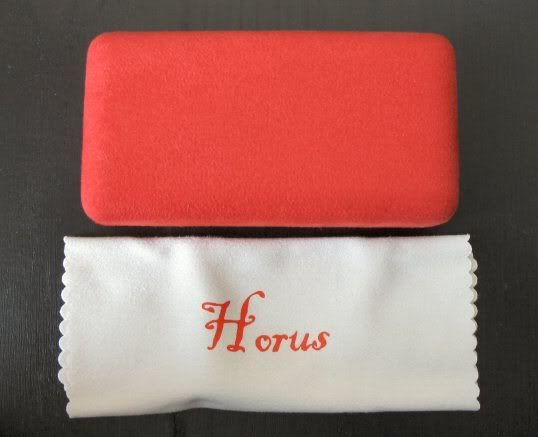
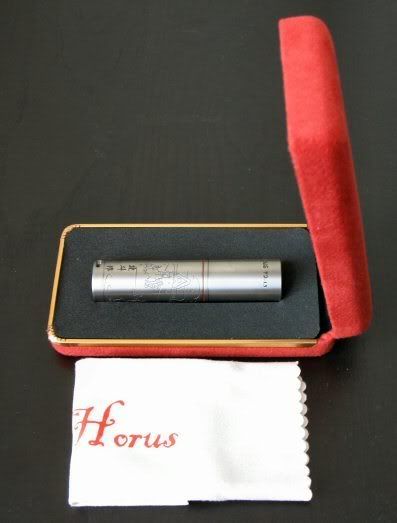
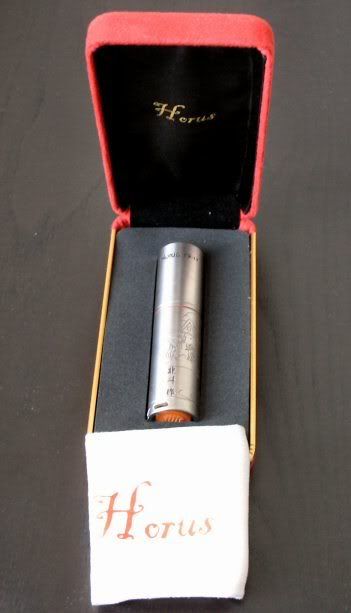
UPDATE: Steven has kindly sent me a titanium dogtag engraved with my website address and done in with "knurling" design. Pic included below so you can see how the knurling feature looks.
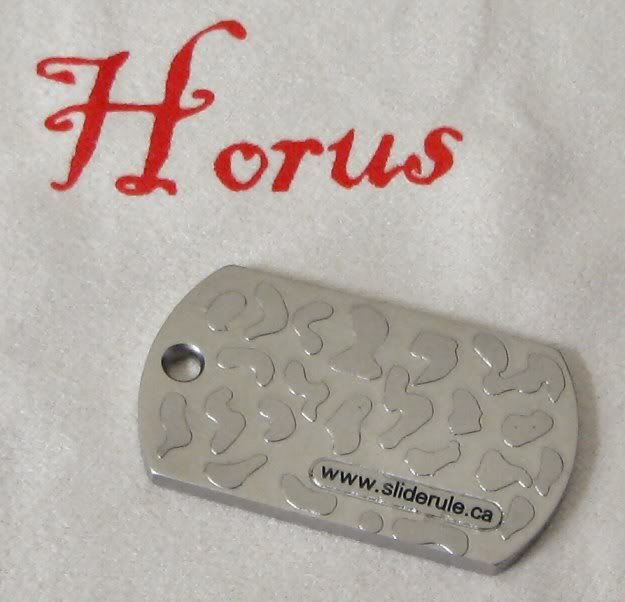
Conclusion:
Pros
Cons
Summary:
A high quality light. The main thing holding me back from giving this light a firm :thumbsup: is the inability to run on primaries. According to Horus, the reason for this is the 3.2V low voltage protection used for unprotected RCRs. Personally, I would rather see the light not have this low voltage protection if it meant you could use primaries. Horus is working on way to try and provide both. Stay tuned for updates ....
Cheers! :wave:

Full details are available in their CPFMP thread, but here's a quick rundown:
- Made of Titanium

- Cree 7090 XR-E Q5 level WC bin LED
- Sapphire lens
- Battery 3.6/3.7V RCR only (i.e. 16340 Li Ion - see below for a discussion)
- Five output modes: Medium (40%) → Low (3%) → High (100%) → Strobe → SOS
- Memory mode for current setting (press and hold switch for 5 secs to activate)
- Constant current output circuit (see below for a discussion)
- Reverse polarity protection built in and low voltage (3.2V) protection (see below for a discussion)
- 84mm ( Length ) x 20.5mm ( Width )
- Aluminum L.O.P. Reflector
- Waterproof to at least 40 meters
- Switch CQC and CE certified (forward clicky)
What came in the package:
For the moment, Steven at Horus has only sent me the light for testing. Full package with extras will be coming soon. Here's what the light looks like:






Beamshots:
On Max with AW protected RCR (blue-label). For comparison purposes, I've also included the Fenix P2D-Q5.





As you can see, the Horus FD-1.3 has a much smoother beam than the Fenix Q5 head, with no sign of the dreaded Cree rings. Initial overal output on max is similar. Tint does indeed seem to be WC on my sample (the Fenix is warm in comparison)
Output/Runtime Method: All my output numbers are relative for my home-made light box setup, a la Quickbeam's flashlightreviews.com method. My relative overall output numbers are typically similar to his, although generally a little lower. You can directly compare all my review graphs - i.e. an output value of "10" in one graph is the same as "10" in another.
Battery Comparison:
Batteries used for testing purposes were AW protected RCR (black-label and older blue-label, 750mAh, 3.7V), Ultrafire Protected RCR (gray-label, "880mAh", 3.6V) and Ultrafire Unprotected RCR (blue-label, "880mAh", 3.7V). The AW batteries were bought direct from AW, and both have had a good number of charging cycles (i.e. blue-label at least a year old, black-label at least 6 months old). The Ultrafires were just purchased from Lighthound, and are brand new.

As you can see, all batteries performed similarly. And given the large number of discharge cycles on my AWs, that tells you something about the supposed "higher" capacity of the brand new Ultrafires.
The light features a low voltage cut-off of 3.2V, so it is quite safe to run unprotected batteries in this light. I confirmed the resting voltage of the unprotected ultrafire was 3.2V as soon as shutdown occured.


As you will notice, light goes into a slow flash/strobe mode on Medium and Low modes once the low voltage protection level is reached. In both cases, I stopped the run after several minutes of flashing. Note that this flash/strobe effect doesn't seem to happen when the light is run on Max mode (i.e. simply shuts off once internal battery protection circuit is tripped, or when 3.2V is reached on unprotected batteries).
Throw Summary:
Hi: 2600 Lux
Med: 1300 Lux
Lo: 120 Lux
Digital Regulation:
- Despite the claim for constant current, the light seems to use PWM for its low modes. For Medium mode, I measured frequency at a decent 159Hz. For Low mode, freq was 91 Hz. Strobe mode is 9 Hz.
- Output is semi-regulated, but Medium and Low are set are good levels relative to Max.
- Nice to see such a low Low level on a Li-ion light. :thumbsup:
User Interface:
- Click once on the tailcap switch to turn on the light, click again to turn off. Next time you turn on, light advances to next mode in the sequence.
- Clicky is a forward clicky, so you can soft-press to momentary turn on the light, and repeatedly soft-press to cycle through the modes.
- To memorize the current mode, press and hold the clicky for 5 secs before turning off. Next time you turn on, you will be in the same mode.
Build Quality
- Overall build quality is quite good. Light feels substantial in the hand (a bit heavier than my P2D).
- Titanium finish is very smooth, and laser engraving is top notch. There are no blemishes or flaws on my sample, which has the name/model number, a winter scene, and the designer's name all engraved on the light. All are very nicely done. Horus advises that they are able to custom engrave your desired logo/scene, as well as was creating a knurling finish.
- Light has black plastic disc in the head for reverse battery protection (i.e. uses a mechanical barrier instead of a circuit). The disc on my sample is a little too thick to allow some batteries to make contact with the head - both my AW black-label and Ultrafire unprotected needed a small magnet on the positive battery nipple to make contact. I do NOT recommend you use these magnets with Li-ions. I have informed Horus, and they have advised me that they will make this barrier thinner on future versions. You can also remove it all together if you want, although this will also remove the reverse polarity protection.
- Forward clicky switch has a different feel to it than most. Not stiff per se, it has a longer traverse than most switches, requiring you to press further to activate. You can still use it for momentary on, and can repeatedly soft-press to cycle modes - however, given the longer traverse, I found it's easy to accidentally click on when trying to repeatedly soft-press. Horus advises that use of this switch was necessitated by their desire to retain waterproofness. Note that the light can tailstand.
Accessories



- Light comes with a red felt case, similar to a jewelery case, and a microfiber cleaning cloth inscribed with the Horus logo.
- Although it makes for a handsome presentation package, something tells me that this is probably not that "special gift" your close female companion would be looking to receive - despite the red Horus logo with a heart shape inside the "o".
- I can just see the poor stunned looked on the guy who gave one of these to his GF/wife ("... but ... but ... it's TITANIUM honey!)

UPDATE: Steven has kindly sent me a titanium dogtag engraved with my website address and done in with "knurling" design. Pic included below so you can see how the knurling feature looks.

Conclusion:
Pros
- Very bright Q5 RCR light, excellent beam profile and tint.
- Good choice of output levels, particularly impressive ultra-low Low level
- Memory mode a useful feature
- Low voltage (3.2V) protection, so you can safely use unprotected RCR
- Seems well-built, worked reliably during testing. Haven't tested waterproofness yet, but advertised 40m is very impressive.
- Forward clicky allowing momentary on and soft-press for mode selection
- Good runtimes given the output.
- Ability to custom laser engrave desired logo or scene, high quality engraving.
- Titanium

Cons
- Inability to run on primary CR123A (but see Summary below ...)
- Mode sequence may not be everyone's preference (similar to Jetbeam C-LE)
- Light not regulated on highest output mode (seems to be direct drive)
- PWM is noticeable on lowest output mode (91Hz)
- Reverse battery protection mechanical instead of circuit-driven, current black disc needs to be thinned down to allow all battery types to make contact (Horus is aware and working on it)
- Forward clicky has a longer traverse to activate than most others
Summary:
A high quality light. The main thing holding me back from giving this light a firm :thumbsup: is the inability to run on primaries. According to Horus, the reason for this is the 3.2V low voltage protection used for unprotected RCRs. Personally, I would rather see the light not have this low voltage protection if it meant you could use primaries. Horus is working on way to try and provide both. Stay tuned for updates ....
Cheers! :wave:
Last edited:


